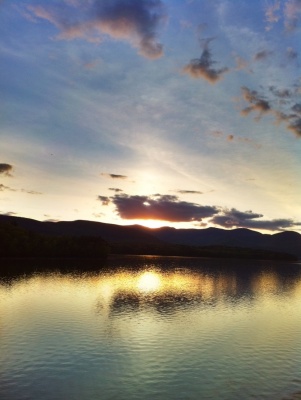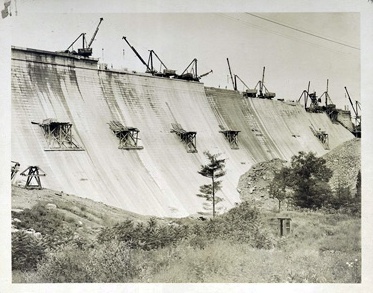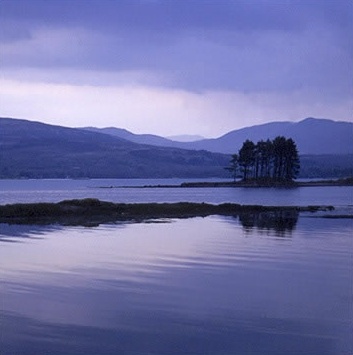
Why call the Ashokan Reservoir, Ulster County's "Gift" to NYC? Like any gift freely given, the giver expects nothing in return, and that's precisely what some residents living near and around the reservoir have gotten from New York City: nothing. Well, at times nothing, other times a little something, and sometimes, much more than they bargained for. But we'll get back to that later. First, join Taft Street Realty as we explore the unique relationship between the Ashokan Reservoir and New York City...
The Birth of a Reservoir: A Prelude of Things to Come
 At the turn of the 20th century, New York City was already a thriving metropolis that was rapidly growing. Basics like water were needed on a massive scale, and city officials soon looked north to the Catskills for their drinking water. Speculators purchased the rights to several water sources throughout the Catskills, and plans were being drafted to flood these water sources to create a giant reservoir (the largest in the world at the time) for New York City. The plan was bitterly contested by small communities in the area whose towns, farms and homes were slated to be washed away forever. In the end, New York City claimed eminent domain over the land, and the State backed the city, amending its constitution to allow for the flooding of several communities. Some towns were relocated, like Ashokan and Olivebridge. Other towns, like Brown's Station, disappeared forever. It was the first, but certainly not the last time, that the needs of New York City took precedence over the rights of property owners upstate.
At the turn of the 20th century, New York City was already a thriving metropolis that was rapidly growing. Basics like water were needed on a massive scale, and city officials soon looked north to the Catskills for their drinking water. Speculators purchased the rights to several water sources throughout the Catskills, and plans were being drafted to flood these water sources to create a giant reservoir (the largest in the world at the time) for New York City. The plan was bitterly contested by small communities in the area whose towns, farms and homes were slated to be washed away forever. In the end, New York City claimed eminent domain over the land, and the State backed the city, amending its constitution to allow for the flooding of several communities. Some towns were relocated, like Ashokan and Olivebridge. Other towns, like Brown's Station, disappeared forever. It was the first, but certainly not the last time, that the needs of New York City took precedence over the rights of property owners upstate.
Ashokan Reservoir's Unique History & Connection to Other Towns in Ulster County
Construction on the Ashokan Reservoir began circa 1910 and though not yet complete, it was pressed into service in 1915, making it the oldest reservoir to serve the New York City Area. The cement used to build its massive walls and dams came locally, from a rough & tumble little mining town called Rosendale, New York. These days, Rosendale, NY homes for sale are very popular among NYC residents, but back in the early 1900's the area's claim to fame was having the world's strongest cement, and only miners and misfits frequented the taverns on Main Street in Rosendale. During its construction, a small reservoir police force was established to maintain order in the often-rowdy labor camps. Legend has it that the New York City Department of Environmental Protection (NYCDEP) eventually evolved from this small group of brave peace officers.
The Ashokan Reservoir Today: Some Facts & Figures...
 In addition to being the oldest reservoir to serve NYC area, the Ashokan Reservoir is also the largest at over 8,000 sq. acres, and also the deepest at 190 feet at the reservoir's center. At its capacity the reservoir can hold up to 122.9 billion gallons of water! Though the weather and droughts can affect the reservoir's release schedule, the Ashokan Reservoir generally releases 15 million gallons of water per day in the summer season and 10 million gallons per day in the winter season! Not too long ago, one used to be able to drive along the rim of the Ashokan on the narrow, paved, path along the spillway. However, following the September 11th attacks, the road was permanently closed to automobile traffic. However, pedestrians are still allowed to stroll along the spillway and enjoy what is easily one of the top 10 beautiful views in Ulster County, NY!
In addition to being the oldest reservoir to serve NYC area, the Ashokan Reservoir is also the largest at over 8,000 sq. acres, and also the deepest at 190 feet at the reservoir's center. At its capacity the reservoir can hold up to 122.9 billion gallons of water! Though the weather and droughts can affect the reservoir's release schedule, the Ashokan Reservoir generally releases 15 million gallons of water per day in the summer season and 10 million gallons per day in the winter season! Not too long ago, one used to be able to drive along the rim of the Ashokan on the narrow, paved, path along the spillway. However, following the September 11th attacks, the road was permanently closed to automobile traffic. However, pedestrians are still allowed to stroll along the spillway and enjoy what is easily one of the top 10 beautiful views in Ulster County, NY!
A Sometimes Rocky Relationship, Muddied by Upstate/Downstate Politics
As of late, the relationship between local residents and New York City has been particularly rocky. The demands of a major urban city, particularly for such a vital commodity as drinking water, oftentimes trump the needs of upstate residents around the reservoir and surrounding waterways. Following Hurricane Irene in the summer of 2011, the Ashokan Reservoir was stirred and muddied with dirt and sediment, known as "turbid water". In a frantic effort to quickly clear up NYC's drinking water, the NYCDEP obtained a permit to release over a billion gallons of turbid water into the lower Esopus Creek over a mere 3 day period; an unprecedented release in terms of scale, and every drop of it turbid water. The effects on the Esopus Creek and the surrounding lands were devastating, causing untold environmental damage, property damage, both immediate flooding and the permanent, long-term, threat of flooding to due to the erosion of creek beds.
 The NYCDEP maintains that the releases were necessary, and in theory would prevent further flooding by creating a void in the reservoir's basin. They point out that New York City does in fact own the development rights to the affected land, and that NYC often pays the property taxes on land affected by NYC's drinking water supply. This argument rings hollow for upstate land owners, for whom "development rights" does not mean a license to dump. They also point out that NYC generally pays only a portion of the property tax, and usually only as much as they need to. For folks who don't even benefit from the water of reservoir, this is hardly their idea of, "Compensations".
The NYCDEP maintains that the releases were necessary, and in theory would prevent further flooding by creating a void in the reservoir's basin. They point out that New York City does in fact own the development rights to the affected land, and that NYC often pays the property taxes on land affected by NYC's drinking water supply. This argument rings hollow for upstate land owners, for whom "development rights" does not mean a license to dump. They also point out that NYC generally pays only a portion of the property tax, and usually only as much as they need to. For folks who don't even benefit from the water of reservoir, this is hardly their idea of, "Compensations".
The Reservoir Not the Only Ulster County Area Negatively Affected by NYC's Drinking Water
The negative effects of NYC's water system are not limited to areas around the reservoir. Underground aqueducts through which the water flows to NYC have over time, succumbed to cracks, deterioration, and the stress of daily use. Property owners whose homes happen to be above these aqueducts have experienced flooding, not of rain or ground water, but of fresh, cold, crystal-clear drinking water. In the town of Wawarsing, NY along a stretch of Route 209, residents recorded the bizarre floods, where water literally squirted out of cracks in their basement. One homeowner estimated the flooding in his home produced up to 8,000 gallons of water per day! The following video is truly stupefying...
Enjoying the Reservoirs, but Staying Aware & Informed
Although many residents and passers-by enjoy the views and vistas that the reservoirs provide, few really know what actually goes on behind the scenes. We here at Taft Street Realty want to bring you not only the good, but the bad and the ugly too. As much as we love Ulster County real estate, it's important to discuss some of the troubles the area faces, as well as highlight the frustrations of locals. Even though we appreciate the culture and other resources brought here from NYC, we also realize how important the area's natural resources are to local residents, and how vital it is that these resources are protected. Ulster County residents understand that there is a need for water in NYC, and don't mind providing it. However since the reservoir's inception, there has existed a David & Goliath dynamic, where the generosity of the small townsfolk is seemingly taken advantage of by the more powerful and influential populous of New York City. Your Thoughts?
Posted by Dylan Taft on
Leave A Comment